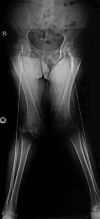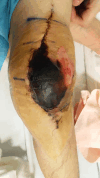Catastrophic skin necrosis after total knee arthroplasty: a case report and review of the literature
- PMID: 38463118
- PMCID: PMC10923309
- DOI: 10.1097/MS9.0000000000001085
Catastrophic skin necrosis after total knee arthroplasty: a case report and review of the literature
Abstract
Introduction and importance: There have been few cases of post total knee arthroplasty (TKA) skin necrosis reported. Here, the authors present our patient with skin necrosis post TKA on account of its extreme rarity, considerable risk factors, and importance of its treatment.
Case: This is a cautionary report on the rule of including previous single longitudinal incision in surgical approach. The authors included previous medial incision in ours and performed arthroplasty through medial parapatellar incisions. After noticing skin necrosis in front of patella, reoperation including flap and skin graft was done, leading to complete recovery.
Clinical discussion: While skin necrosis post TKA is not common, it can be present in high-risk patients who should be considered for a decrease in their risk factors. Preoperatively, underlying diseases should be under control. Intraoperation risk factors, in particular incision selection, and considerations about lateral retinacular release are important.
Conclusion: A balance must be achieved between the ability to expose the knee through a prior incision and avoiding extensive undermining of the subcutaneous flaps in patients with previous knee surgery. It may be a better approach to ignore medial incisions and use the classic midline incision.
Keywords: arthroplasty; knee; necrosis; skin; wound complication.
Copyright © 2024 The Author(s). Published by Wolters Kluwer Health, Inc.
Conflict of interest statement
None.Sponsorships or competing interests that may be relevant to content are disclosed at the end of this article.
Figures






Similar articles
-
Outcomes of Total Knee Arthroplasty Following a Sham Incision Procedure in Patients with Previous Knee Incisions.J Bone Joint Surg Am. 2024 Nov 6;106(21):1986-1990. doi: 10.2106/JBJS.24.00114. Epub 2024 Sep 25. J Bone Joint Surg Am. 2024. PMID: 39321307
-
The distance between new and previous incisions does not affect skin necrosis in total knee arthroplasty: a parallel-randomized controlled clinical trial.BMC Surg. 2022 Sep 26;22(1):350. doi: 10.1186/s12893-022-01791-w. BMC Surg. 2022. PMID: 36163060 Free PMC article. Clinical Trial.
-
[Management of skin necrosis around incision following total knee arthroplasty].Zhongguo Xiu Fu Chong Jian Wai Ke Za Zhi. 2014 Aug;28(8):985-7. Zhongguo Xiu Fu Chong Jian Wai Ke Za Zhi. 2014. PMID: 25417313 Chinese.
-
Midline versus anterolateral incisions for total knee arthroplasty-a systematic review and analysis of the angiosomes of the knee.ANZ J Surg. 2021 Oct;91(10):2167-2173. doi: 10.1111/ans.17136. Epub 2021 Aug 17. ANZ J Surg. 2021. PMID: 34405531
-
[Extensor mechanism complications in revision total knee arthroplasty : Joint exposure and prevention of extensor mechanism complications].Orthopade. 2016 May;45(5):376-85. doi: 10.1007/s00132-016-3260-y. Orthopade. 2016. PMID: 27147428 Review. German.
References
-
- Scuderi GR. Avoiding postoperative wound complications in total joint arthroplasty. J Arthroplasty 2018;33:3109–3112. - PubMed
-
- Ries MD. Skin necrosis after total knee arthroplasty. J Arthroplasty 2002;17(4 suppl 1):74–77. - PubMed
-
- Patella V, Speciale D, Patella S, et al. . Wound necrosis after total knee arthroplasty. Orthopedics 2008;31:807. - PubMed
Publication types
LinkOut - more resources
Full Text Sources
